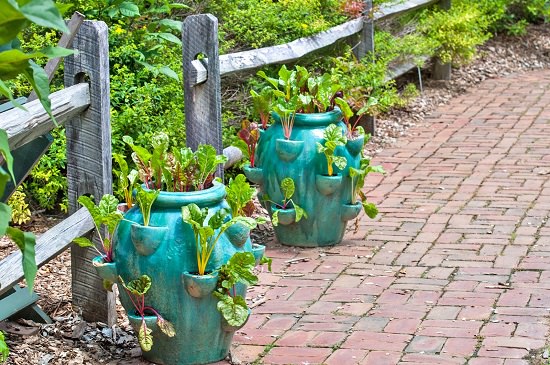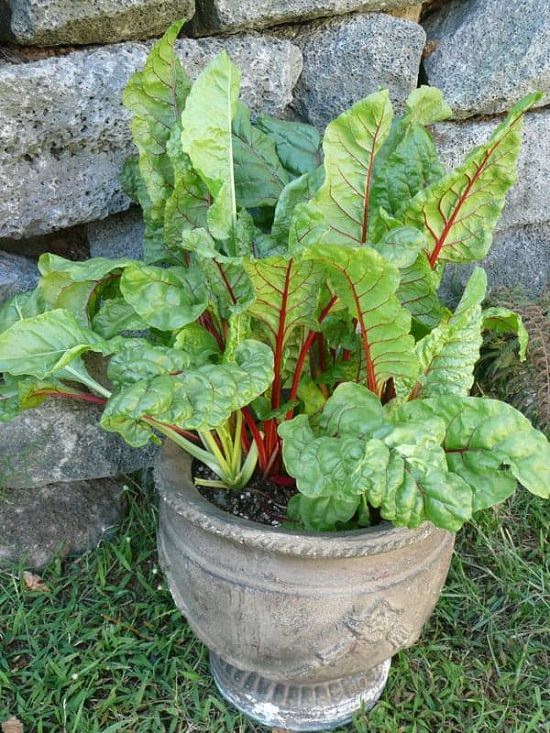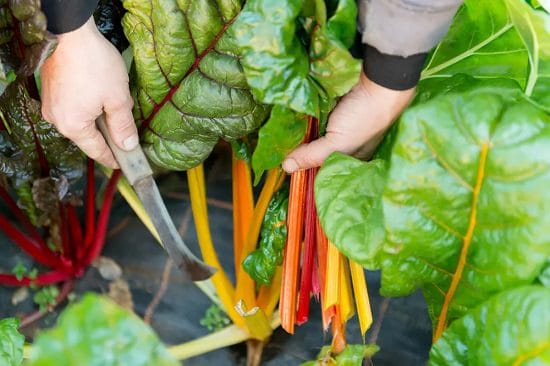Learn all about Growing Swiss Chard in Pots and toss this nutritious leafy green fresh in salads and your favorite meals!

Swiss chard is a nutritional leafy green with many health benefits. Growing it in pots not only saves space but also ensures that you have a fresh supply at hand, whenever required! Its needs are not much different from lettuce, kale, and other leafy greens. Just go through this Growing Swiss Chard in Pots guide for more information!
Here are some of the best leafy greens you can grow in containers!
Planting Swiss Chards
Swiss chard is a cool-season crop and grows best in spring and fall. It can also bear rising temperatures, but the growth slows down in summers. Start planting seeds indoors 2-3 weeks before the last spring frost date.
If you are looking forward to having harvest in autumn, plant the seeds in late summer, you can continuously do this until 40-45 days before the first predicted frost date. If you live in a hot climate (USDA Zones 10, 11), the best chard growing time is late fall, winter, and early spring.
Pro Tip: For a continuous harvest, do successive planting–Sow seeds every two weeks, throughout the growing season.
Choosing a Container

For swiss chards, it’s always a good idea to go with small to medium-sized containers. Opt for 8 inches deep and wide planter with adequate drainage holes at the bottom. You can go for the clay, terracotta, concrete, or plastic pots. In such a container, you can grow 2-3 plants.
Requirements for Growing Swiss Chard in Pots
Location
Find the sunny spot to place the pot there! It can tolerate part sun as well. If you’re growing it in a hot climate or when the temperature is warm, the best location would be that receive shade in the afternoon. Indoors you can put it on a sunny windowsill or close to a south-facing window, without drapes.
Soil
For growing healthy swiss chard, use a good quality soil mix with plenty of organic matter. You can add compost for this! Also, the soil must be loamy, well-draining, neutral in pH. Avoid acidic soils.
Spacing
If you’re growing multiple plants together for a plentiful harvest, then keep them 4-5 inches apart in your container. Grow them more closely if you are short of space and try cut and come again method–Keep trimming the older, outside leaves first for harvest and allowing the smaller, tender leaves to grow. This way, you won’t have to care much about spacing. But remember, growing swiss chard more closely will result in smaller leaves.
Watering
Follow the similar watering practice from day one to the day your crops die. Keep the potting soil evenly moist. Shallow pots will require more frequent watering, but do ensure that you are not overwatering this vegetable as it’s always detrimental.
Swiss Chard Care
Fertilizing
Mixing one-fourth of aged manure to the potting soil at the time of planting is enough for the growth of this leafy green. During the midseason, if you like, side-dress the pots with a handful of compost. If you notice slow growth or didn’t add compost, feed your crop with balanced liquid fertilizer once a month.
Mulching
Swiss chard grows best in evenly moist soil, but keeping the soil moist at the right level can be quite a task, and this is where mulching helps! You can add a 1-inch layer of mulch around the base of plants. Straws, pine needles, finely ground leaves or bark, are ideal mulching materials.
Pests and Diseases
You have to be careful about caterpillars, cutworms, aphids, maggots, and beetles as they can cause damage to the leaves and plants. Either remove them by hand or get rid of them with a spray of water. If it doesn’t help, use insecticidal soap or organic neem oil solution. Mildew and leaf spots are common diseases that can affect chard.
Want to get rid of pesky pests? Click here!
Harvesting
 Usually, after 8 weeks, you can start harvesting swiss chards for salads. Wait for a couple more weeks for them to be cooking ready. Cut individual leaves as per your requirements, and the plant will continue to grow the new ones. Don’t forget to trim the old, maturing leaves first.
Usually, after 8 weeks, you can start harvesting swiss chards for salads. Wait for a couple more weeks for them to be cooking ready. Cut individual leaves as per your requirements, and the plant will continue to grow the new ones. Don’t forget to trim the old, maturing leaves first.
How to use Swiss Chard
- The leaves are delicious when eaten fresh. Using them in salads is going to enhance the taste further!
- You can also sauté the leaves with garlic or other aromatic herbs and spices.
- Bake the leaves with pork chops!
- Steamed Swiss chard tastes yummy with creamy béchamel and spring onions!
- Sautéd leaves can also be used in frittata by wrapping eggs in them.
- You can also add them to miso soup.


